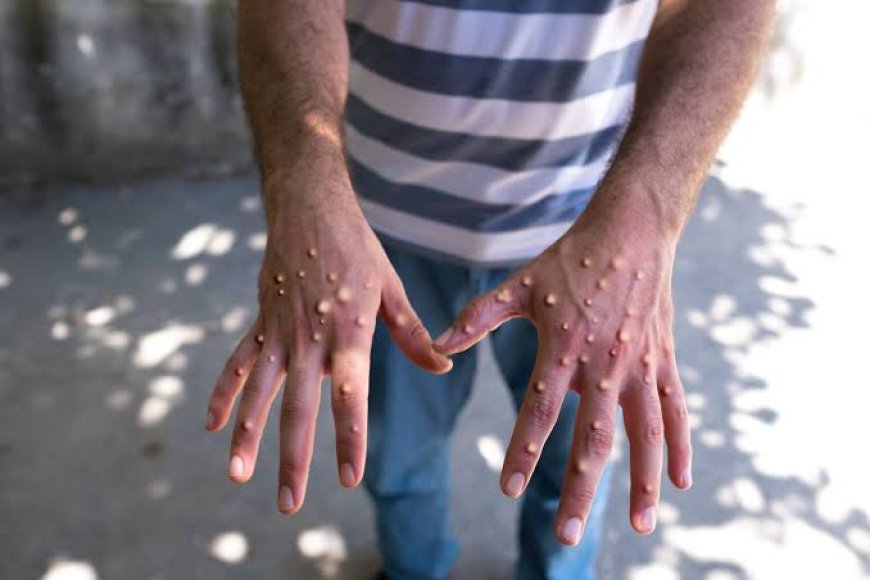Mpox Virus: What you need to know

Thursday, 15 August, 2024
McCreadie Andias
World Health organization (WHO) Director-General Dr. Tedros Adhanom Ghebreyesus in a press release on Wednesday, 4 August, 2024, determined that the upsurge of mpox in the Democratic Republic of the Congo (DRC) and a growing number of countries in Africa constitutes a public health emergency of international concern (PHEIC) under the International Health Regulations (2005).
This follows a warring trend of infections leading to deaths and complications especially across the African continent.
The Africa Centre for Diseases Control (CDC), previously said mpox, also known as monkeypox, has been detected in 13 countries this year, and more than 96% of all cases and deaths are in Congo.
Cases are up 160% and deaths are up 19% compared with the same period last year. So far, there have been more than 14,000 cases and 524 people have died.
But first, how did this virus come to be, what are its signs and symptoms, how can it be prevented and more.
About Mpox
Mpox (formerly known as monkeypox) is a disease caused by infection with a virus, known as Monkeypox virus. This virus is part of the same family as the virus that causes smallpox. Mpox is, however, not related to chickenpox.
Mpox is a zoonotic disease, meaning it can be spread between animals and people. It is endemic, or found regularly, in parts of Central and West Africa.
The virus that causes mpox has been found in small rodents, monkeys, and other mammals that live in these areas.
Discovery and History
Monkeypox virus was discovered in 1958, when two outbreaks of a pox-like disease occurred in colonies of monkeys kept for research.
Despite being named “monkeypox” originally, the source of the disease remains unknown. Scientists suspect African rodents and non-human primates like monkeys might harbor the virus and infect people.
The first human case of mpox was recorded in 1970, in the Democratic Republic of the Congo. In 2022, mpox spread around the world. Before that, cases of mpox in other places were rare and usually linked to travel or to animals being imported from regions where mpox is endemic.
The World Health Organization renamed the disease in 2022 to follow modern guidelines for naming illnesses.
Those guidelines recommend that disease names should avoid offending cultural, social, national, regional, professional or ethnic groups and minimize unnecessary negative effects on trade, travel, tourism or animal welfare.However, The virus that causes it still has its historic name.
Virus Types
There are two types of Monkeypox virus: clade I and clade II.
Clade I causes more severe illness and deaths. Some outbreaks have killed up to 10% of the people who get sick, although more recent outbreaks have had lower death rates. Clade I is endemic to Central Africa.
Clade II is the type that caused the global outbreak that began in 2022. Infections from clade II mpox are less severe. More than 99.9% of people survive. Clade II is endemic to West Africa.
Signs and Symptoms
People with mpox often get a rash that may be located on hands, feet, chest, face, or mouth or near the genitals, including penis, testicles, labia, and vagina, and anus.
The incubation period is 3–17 days. During this time, a person does not have symptoms and may feel fine.
The Mpox rash will go through several stages, including scabs, before healing.The rash can initially look like pimples or blisters and may be painful or itchy.
Some of the extended signs include Fever, Chills, Swollen lymph nodes, Exhaustion, Muscle aches and backache, Headache, respiratory symptoms (e.g., sore throat, nasal congestion, or cough).
Typically, mpox symptoms start within 21 days of exposure to the virus. If you have flu-like symptoms, you will likely develop a rash 1–4 days later. If you have symptoms, such as a rash, you are advised to visit a healthcare provider.
Means of spreading
Both types of the virus can spread through:
The virus can be spread through direct contact with infected animals by means of kissing animals, cuddling or touching them.
Close or Intimate Contact: Oral, anal, or vaginal sex, or touching the genitals (penis, testicles, labia, and vagina) or anus, Hugging, massage, and kissing.
Prolonged face-to-face interactions such as talking or breathing
Touching contaminated Objects: Mpox virus can spread to anyone through contact with objects, fabrics, and surfaces that have not been disinfected after use by someone with mpox. This includes items like clothing, bedding, towels, fetish gear, or sex toys.
Pregnant people with mpox can pass the virus to the fetus during pregnancy or to the newborn during and after birth.
Although cases of mpox are not life-threatening, some people may be more likely to get severely ill.
Preventive measures
A person with Mpox can spread it to others from the time symptoms start until the rash has fully healed and a fresh layer of skin has formed.Some people can spread mpox to others from 1 to 4 days before they have symptoms.
Avoiding close, skin-to-skin contact with people who have a rash that looks like mpox and animals that carry the Mpox virus.
Learning steps you can take to lower your risk of mpox during sex or at a social gathering.
Getting vaccinated. Check with your healthcare provider to find out if the Mpox vaccine is recommended for you.
If you have a new or unexplained rash or have other Mpox symptoms, especially after potential exposure, you are advised to visit a healthcare provider.
If you think you have mpox or have had close personal contact with someone who has mpox, visit a healthcare provider to help them decide if you need to be tested for mpox.
Get tested if recommended. If your healthcare provider decides that you should be tested, they will collect the specimens and send them to a laboratory for testing.
Wear a mask. When you see a healthcare provider, wear a mask.
Avoid close contact with an animal that might have mpox.Those who have mpox should avoid contact with animals, including pets, to prevent spreading the virus to them.
People are less likely to get mpox from a pet, but it’s possible. Close contact with a pet that is infected, including petting, cuddling, hugging, kissing, licking, and sharing sleeping spaces or food, can spread mpox to a person.
Testing
Currently, testing is only recommended if you have a rash consistent with mpox.
If you think you have mpox or have had close personal contact with someone who has mpox, consider taking precautions and visit a healthcare provider to help you decide if you need to be tested for mpox.
Only a healthcare provider can order an mpox test.
The healthcare provider may take a specimen and send it to a lab for testing or they may send you to a lab for both specimen collection and testing.
You will likely need to fill out paperwork before you get tested.To get a specimen to test, the healthcare provider will use a swab to rub vigorously across lesions of your rash. They will take swabs from more than one lesion.
This swabbing may be uncomfortable but is necessary to get enough material to detect the mpox virus from the specimens.
The specimens will be tested in a lab to see if the mpox virus is detected.
Results are usually available within a few days.
If your test result is positive,you are advised to take the necessary steps to protect yourself and others until you have completely recovered from your infection.
If your test result is negative, continue to take steps to protect yourself and others: a negative test result means the test did not detect the virus and you probably do not have mpox.
If your test result is inconclusive: that means that your test will need to be conducted again because not enough of the specimen was taken.
Tests conducted by public health departments are usually free while testing referrals from a private healthcare provider to a commercial lab or tests done in the hospital may involve a fee.
Treatment
A Mpox treatment is Referred to as Tecovirimat.
Oral TPOXX (tecovirimat) for treatment of mpox is primarily available through the Study of Tecovirimat for Mpox (STOMP).
However, because there are not enough data to say whether tecovirimat is safe and effective for treating people who have mpox, tecovirimat is still considered an experimental drug for mpox.
Experimental means the drug is still being tested to determine whether it is safe and effective to treat a specific disease.
If your healthcare provider thinks you have mpox, they may ask you to consider taking part in STOMP.
What's Your Reaction?



































































































































































































































































































